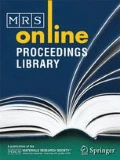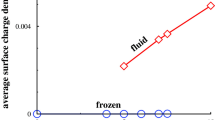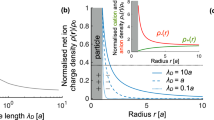Abstract
Non-Debye and constant-phase-angle (CPA) behaviors associated with the bulk and interfacial processes involving ionic materials are discussed in terms of complex impedance, admittance, and dielectric spectra. The yielding of a CPA and/or a broad non-Debye dielectric loss peak in a spectrum from fractal, pore, and ion-hopping models are compared and reviewed. The observed wide frequency ranges of the CPA behavior suggest that the fractal and pore models, which require a wide range of special structures down to very fine scales, may not be realistic. The ion-hopping model treats the bulk and interfacial processes as a chemical reaction having a thermally-activated Arrhenius form. Because of thermal fluctuations, the activation energies for ion hopping (e.g., in a potential double-well) have a double-exponential distribution which yields a non-Debye dielectric loss peak and a CPA spectrum over a wide frequency range above the loss peak. The distribution also has a special temperature dependence which may explain the invariance of dielectric spectral shapes with temperature, an observation by Joscher. The construction of CPA elements (in a generalized Warburg impedance form) using three distinct types of resistor-capacitor networks are presented and used to aid the discussion.
Similar content being viewed by others
References
A. K. Jonscher, Dielectric Relaxation in Solids. Chelsea Dielectrics Press, London (1983).
J. C Wang, J. Electrochem. Soc. 134, p. 1915 (1987).
S. H. Liu, Phys. Rev. 55, p. 529 (1985).
J. C Wang, Solid State Ionics 39, p. 277 (1990).
J. C Wang and J. B. Bates, Solid State Ionics 18/19, p. 224 (1986).
L. Nyikos and T. Pajkossy, Electrochim. Acta 30, p. 1533 (1985).
J. C. Wang, Solid State Ionics 28–30, p. 1436 (1988).
T. Pajkossy and L. Nyikos, J. Electrochem. Soc. 133, p. 2061 (1986).
J. C. Wang, Electrochim. Acta 34, p. 987 (1989).
T. Kaplan, L. J. Gray, and S. H. Liu, Phys. Rev. B35, p. 5379 (1987).
P. Debye, Polar Molecules. Dover, New York (1929).
J. C Anderson, Dielectrics. Reinhold, New York, p. 67 (1964).
S. Havriliak and S. Negami, Polymer 8, p. 161 (1967).
C. J. F. Böttcher and P. Bordewijk, Theory of Electric Polarization. Elsevier, Amsterdam (1978).
J. C. Wang and J. B. Bates, Mat. Res. Soc. Symp. Proc. 135, p. 57 (1989).
J. C. Wang and J. B. Bates, Solid State Ionics 50, p. 75 (1992).
G. H. Vineyard, J. Phys. Chem. Solids 3, p. 121 (1957).
J. M. Wimmer and N. M. Tallan, J. Appl. Phys. 37, p. 3728 (1966).
E. Warburg, Ann. Phys. 6, p. 125 (1901).
J. B. Bates and J. C. Wang, Solid State Inoics 28–30, p. 115 (1988).
J. C. Wang, Electrochim. Acta 38, p. 2111 (1993).
Author information
Authors and Affiliations
Rights and permissions
About this article
Cite this article
Wang, J.C. Non-Debye and CPA Behaviors of Ionic Materials. MRS Online Proceedings Library 500, 261 (1997). https://doi.org/10.1557/PROC-500-261
Published:
DOI: https://doi.org/10.1557/PROC-500-261




